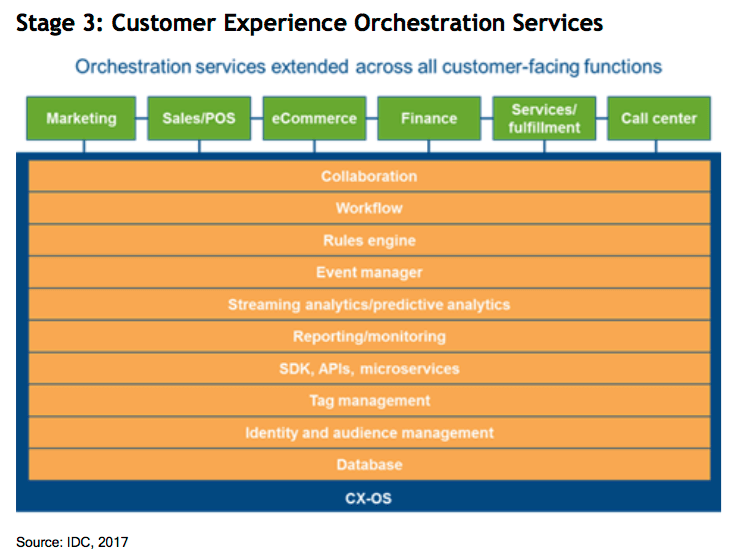Beyond the martech stack: It takes an orchestra to solve the customer experience
The vision of a customer-focused single entity is becoming the Holy Grail for brands.
If you look at what many vendors are saying these days, it’s all about customer experience. Adobe, Salesforce and Sprinklr, for instance, have redefined their identities in that direction.
But reorientation is not enough, according to research firm IDC. Consider a vision of “Customer Experience Orchestration Services” that extend beyond the marketing department, articulated in an IDC study earlier this year from analysts Gerald Murray and Maureen Fleming:
Customer experience (CX) is simply unmanageable at most large companies. Traditional approaches to organizational design and technology deployment based on big corporate functions such as marketing, sales, fulfillment, services, contact center, or fill in the blank result in an inherently fragmented customer experience. Marketing doesn’t know how finance interacts with customers, and services doesn’t know what sales has said. Customers have to retell their stories as they move through these different points of contact.
Murray and Fleming outline two initial stages in the development of marketing/sales tools. In the first, applications were separate silos, many defined by departmental budgets. In the second, the martech “stack” moves some workloads — such as reporting or identity management — to core services.
In the third stage of CX orchestration services, customer-facing responses extend across every department in a flexible architecture that, for instance, could be based on open APIs and microservices:
IDC points to the increasingly popular “buy button” as an example of a customer-facing service that contains all of its necessary functionalities, is decoupled from a commerce system and can live across departments.
Some vendors that are taking the lead toward this CX-OS, the analysts say, include Salesforce (with its flexible Thunder event processing engine and Lightning app and interface builder), Oracle (with platform-wide identity management), Adobe (a variety of core services) and IBM (Universal Behavior Exchange for sharing customer data between solutions).
As an example of what this might mean for a customer, Murray suggested to me a scenario where a brand has an email blast lined up to upsell a new product version to current owners of that product. Just before it goes out, a customer calls and tries to return the product because of a perceived defect.
‘Raises the bar’
In an ideal world of customer experience bliss, the customer’s interaction with the call center for returning a product is immediately conveyed to the email marketing component.
Instead of the email to that customer going out with a message about “here’s an updated version of the product,” it becomes a message of: “we are working on fixing the problem with your product.”
And/or there might be a real-time communication with the customer, via a bot or a social media manager over, say, a messaging app.
In another example, Murray points to a bank that has connected its cash machine to its marketing tools. If you leave your cash card in the machine, it immediately texts you to let you know.
“It raises the bar for customer expectations,” he said.
Murray added that, even though many modern brands have become digital, few have set up an organization, tools or data that communicates as one membrane through all the departments.
It requires creating a “customer-centric organization, not just a customer-centric marketing department,” he said. Murray noted that the transformation is similar to how changes in supply chains have rebuilt some organizations, except here it is the chain of interactions defining a relationship with a customer.
Because of the complexity, he said, you “need a service layer that is designed around the servicing of the customer,” instead of just passing the data into repositories for recall later. It’s a kind of “nervous system for customers,” Murray said.
There are a variety of ways beyond CX-OS to articulate this vision, but they are converging on this same theme: the brand knows about — and responds to — the customer through all of its touch points, immediately.
The new Holy Grail
The idea of the Customer Data Platform, for instance, offers a centralized organization of customer info that similarly wants the customer’s latest interaction with customer service to be immediately available to the email marketing application. The Open Garden approach of connecting disparate organizational components through a data layer seeks to distribute information — including customer information — immediately throughout all digital tools.
But the main idea in these and other approaches is a vision that goes beyond the multiple, hopefully synchronized, lanes of omnichannel marketing.
It’s the new Holy Grail for marketing.
Just this week, for instance, a startup called Pascal 51 — run by former execs from Oracle, Salesforce, IBM and elsewhere — announced a seed round to pursue a “next-generation machine-intelligent customer experience automation platform powered by artificial intelligence and deep machine learning” that can respond to the wandering path of today’s customer journeys.
“Marketing stack” has been a way of describing the hierarchy of tools that establish the modern digital toolset. But, with “customer experience” the current refrain across many brands, perhaps the more appropriate metaphor is now an orchestra.
Opinions expressed in this article are those of the guest author and not necessarily MarTech. Staff authors are listed here.
Related stories

